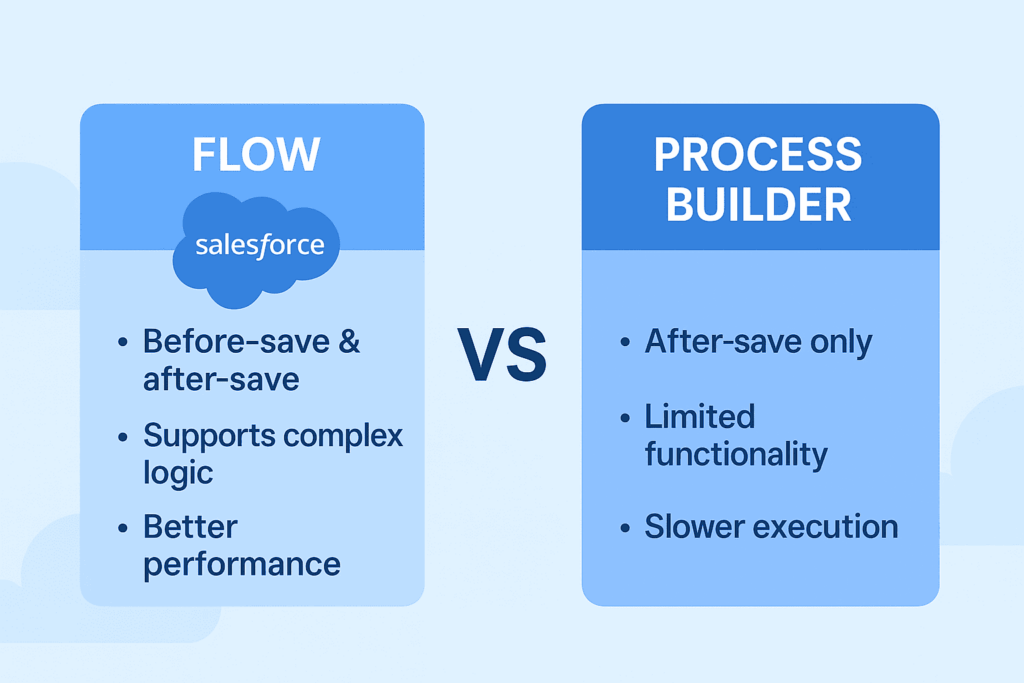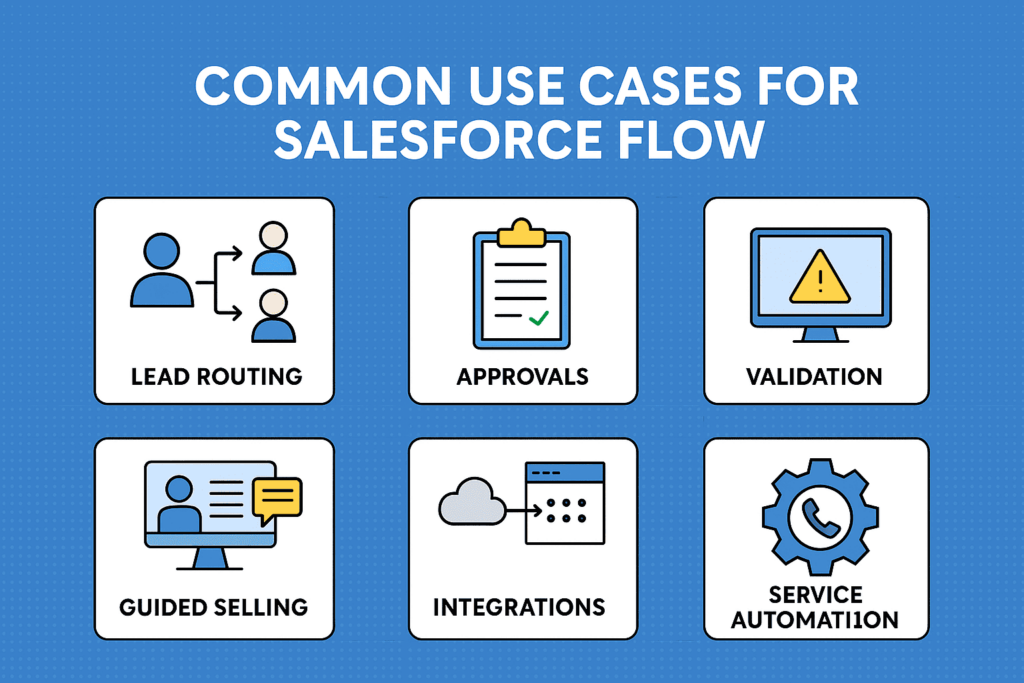Salesforce Flow vs Process Builder: Key Differences and Migration Path
Salesforce Flow is the modern automation tool that supports before-save triggers, complex logic, and higher performance. Process Builder is limited, runs only after-save, and is officially deprecated, making Flow the strategic choice for Salesforce automation.

Why the Comparison Matters
For years, Salesforce offered multiple automation tools in Salesforce — often referred to as Salesforce automation tools — including Workflow Rules, Process Builder, and Flow. This shift has sparked the long-standing debate of Workflow Rules vs Process Builder vs Flow, highlighting why Flow is now the strategic choice for automation. Understanding the difference between Flow and Process Builder in Salesforce is critical for anyone managing complex business logic.
The official Process Builder deprecation reinforces Salesforce’s focus on Flow as the single automation platform for the future.
The importance of this comparison lies in three areas:
- Strategic direction: Salesforce is investing exclusively in Flow.
- Performance requirements: Enterprises need efficient automation with minimal governor limit impact.
- Maintainability: Future-proof solutions require flexibility, modularity, and visibility for debugging.
Thus, choosing between Flow vs Process Builder is no longer optional — it is a transition every Salesforce customer must address, often requiring careful Flow migration best practices to reduce risks and technical debt.
Core Differences Between Flow and Process Builder
The distinction between these two tools is both technical and functional. While both were designed for automation, their capabilities diverge significantly.
- Execution timing
- Flow: can run before-save and after-save, reducing DML operations.
- Process Builder: only executes after-save, making it less efficient.
- Complexity support
- Flow: handles loops, variables, collections, and decision trees.
- Process Builder: limited to basic branching and actions.
- Performance impact
- Flow: faster execution, optimized for high-volume data changes.
- Process Builder: heavier use of system resources.
- Error handling
- Flow: includes debugging tools, error screens, and transaction logs.
- Process Builder: relies mainly on email error notifications.
- Extensibility
- Flow: integrates with Apex, Lightning Web Components, and external APIs.
- Process Builder: restricted to predefined actions.
Flow also connects seamlessly with AppExchange Development solutions for custom extensions.
In summary, Salesforce Flow provides a modern, scalable framework for enterprise automation, while Process Builder represents a legacy approach no longer aligned with Salesforce’s roadmap.
Migration from Process Builder to Flow
Migrating from Process Builder to Flow is the critical step for any organization comparing Salesforce Flow vs Process Builder in real-world automation.
Transitioning from Process Builder requires a structured approach rather than a simple replacement. Recommended best practices include:
- Inventory existing automation: Document all active processes.
- Prioritize business-critical automations: Focus first on revenue-impacting logic.
- Consolidate processes: Replace multiple builders with a single optimized Flow.
- Use subflows: Break automation into reusable building blocks.
- Test extensively: Deploy changes in a sandbox, run regression tests, and validate with end users.
- Monitor after go-live: Track performance metrics and error logs for early issue detection.
By following this strategy, organizations minimize risks, reduce technical debt, and align their Salesforce org with long-term product evolution.
Why Flow Is the Future of Automation
The replacement of Process Builder with Flow is not only about efficiency — it reflects Salesforce’s unified automation strategy. Flow now powers:
- Record-triggered logic for updates and validations
- Screen flows for guided user interactions
- Orchestration for multi-step approvals and cross-department processes
- Integration with APIs and external applications
- Reusable templates that scale across business units
Flow is therefore not just a successor but the central automation hub in Salesforce, consolidating functionality that previously required multiple tools.

Common Use Cases for Salesforce Flow
Salesforce Flow is more than just a replacement for Process Builder — it’s the foundation for scalable business automation. Real-world use cases show why Flow is now the preferred tool:
- Lead assignment and routing – Automatically assign leads to the right sales rep based on territory, industry, or deal size.
- Approval workflows – Replace email-based approvals with streamlined, multi-step approval processes directly in Salesforce.
- Data validation and enrichment – Ensure data quality by running validation checks and enriching records before they are saved.
- Guided selling with Screen Flows – Provide sales teams with step-by-step guidance during opportunity creation or deal progression.
- Integration with external apps – Trigger APIs to update ERP, Slack, or other business systems when Salesforce data changes.
- Customer service automation – Automate case escalation, SLA tracking, and post-resolution surveys.
By leveraging these Salesforce Flow use cases, organizations can not only replicate what Process Builder used to handle but also unlock advanced scenarios that were previously impossible without custom Apex code.
Conclusion: Migrating to Flow and Next Steps
Migrating from Process Builder to Flow is not just a technical upgrade — it is a strategic move that aligns your Salesforce org with the platform’s future. Flow delivers faster performance, greater flexibility, and scalability that legacy tools cannot provide.
If your organization needs guidance in planning, implementing, or optimizing Salesforce automation, our experts are here to help. Contact us to discuss your migration strategy and ensure a smooth transition to Salesforce Flow.
FAQ Section
What is the difference between Process Builder and Flow in Salesforce?
Flow is more advanced, supports before-save execution, loops, and integrations. Process Builder is limited to simple after-save automations.
Which runs first, Flow or Process Builder?
Record-triggered Flows execute before Process Builders. In fact, Salesforce recommends migrating to Flows for predictable performance.
Do we still use Process Builder in Salesforce?
Yes, existing ones still run, but creation of new Process Builders is discouraged. Salesforce has deprecated it.
How to migrate from Process Builder to Flow?
Start by auditing current processes, rebuild them as Flows, test in a sandbox, and deploy step by step.
Why is Salesforce replacing Process Builder with Flow?
Because Flow offers better scalability, lower resource consumption, and alignment with Salesforce’s future roadmap.
What are the best practices for Flow migration in Salesforce?
The best practices for Flow migration in Salesforce include:
- Inventory existing automation: Document all Workflow Rules and Process Builders before replacing them.
- Prioritize critical processes: Start with business-critical automations that directly impact revenue.
- Consolidate logic: Replace multiple Process Builders with a single, optimized Flow where possible.
- Use subflows: Break automation into reusable building blocks for maintainability.
- Test in a sandbox: Validate with regression tests and end-user feedback before production deployment.
- Monitor after go-live: Track performance metrics and error logs to catch issues early.
Following these Flow migration best practices reduces risks, minimizes technical debt, and ensures a smooth transition aligned with Salesforce’s long-term automation strategy.